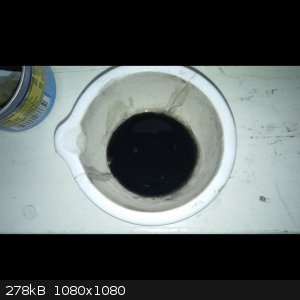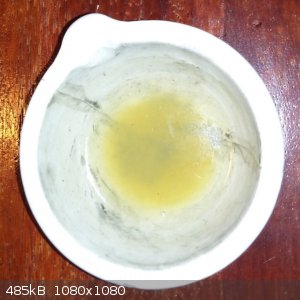Jose
Harmless

Posts: 17
Registered: 18-12-2016
Member Is Offline
Mood: No Mood
|
|
Iron sulfide experiment
I am trying to produce Ferrous/Ferric sulfate from ferrous sulfide. The way I went about it was to first prepare CaS by thermal reduction of CaSO4
with aluminum:
CaSO4+Al=CaS+ Al2O3
Next, I mixed CaS with Ammonium Carbonate found in fermented urine to make ammonium sulfide. I then reacted the Ammonium sulfide with ferric Chloride
and a black precipitate formed.
After left for several days the black precipitate dissapeared leaving a yellow slurry. I want to know if the dissapearance of the black precipitate
was caused by slow oxidation or the ferrous sulfide turned back to ferric oxide.
|
|
|
Jose
Harmless

Posts: 17
Registered: 18-12-2016
Member Is Offline
Mood: No Mood
|
|
Here is the picture of precipitated solid.
[Edited on 7-6-2020 by Jose]

|
|
|
Jose
Harmless

Posts: 17
Registered: 18-12-2016
Member Is Offline
Mood: No Mood
|
|
Here's the solid after air oxidation.
[Edited on 7-6-2020 by Jose]

|
|
|
Ubya
International Hazard
    
Posts: 1247
Registered: 23-11-2017
Location: Rome-Italy
Member Is Offline
Mood: I'm a maddo scientisto!!!
|
|
ferrous sulfide is quite stable, I doubt it oxidizes that easily in air.
That yellow doesn't look like iron oxide, could it be an iron polysulfide? you didn't wash the precipitate and left it for many days in excess of
sulfide ions
---------------------------------------------------------------------
feel free to correct my grammar, or any mistakes i make
---------------------------------------------------------------------
|
|
|
Boffis
International Hazard
    
Posts: 1867
Registered: 1-5-2011
Member Is Offline
Mood: No Mood
|
|
Oh yes it does! particularly precipitated iron sulphide with a composition close to FeS. Iron sulphides closer to pyrite/marcasite FeS2 are a little
more stable but the grain size of precipitated iron sulphide is probably less than 1 micron so even FeS2 will oxidize rapidly. However the products of
oxidation are many and varied according to the conditions. In the presence of large amounts of water yellow ferric hydrate, a ferric hydoxide sulphate
phase and sulphur are usually the main products. In a restricted supply of water ferric sulphates and sulphuric acid are the main products. While with
a restricted supply of oxygen and fairly acid condition ferrous sulphate and mixed ferrous ferric sulphates form.
Take a look at the iron sulphate minerals on Mindat.org there are dozens, particularly if you through in a trace of potassium, sodium etc.
Out of curiosity what are you trying to achieve? What is your aim?
|
|
|
Jose
Harmless

Posts: 17
Registered: 18-12-2016
Member Is Offline
Mood: No Mood
|
|
I am trying to get ferrous sulfate from air oxidation of iron sulfide. Just figuring out what conditions are needed and what to look out for.
|
|
|